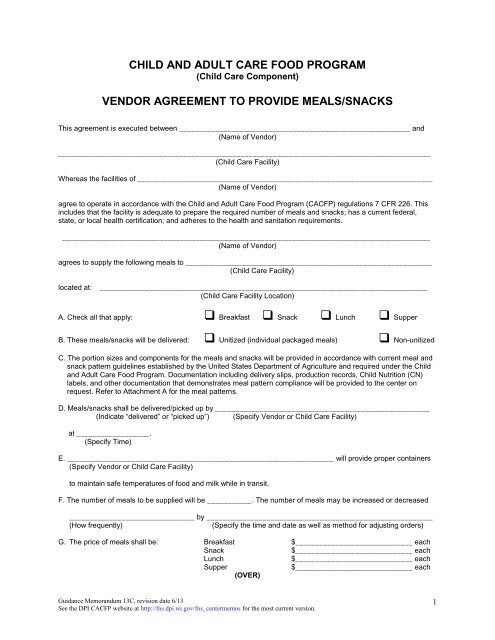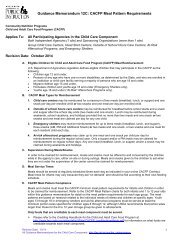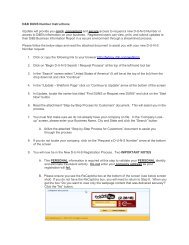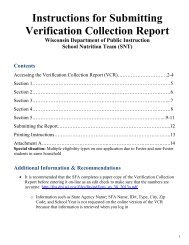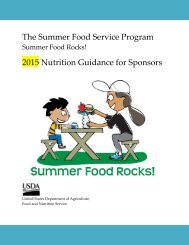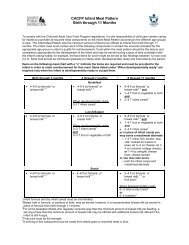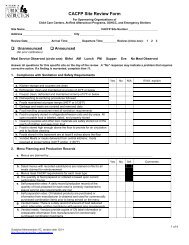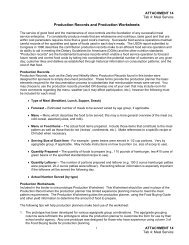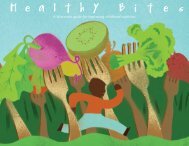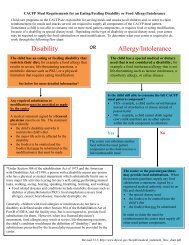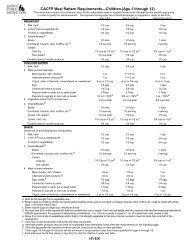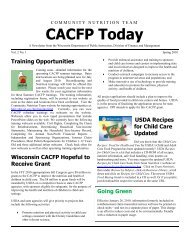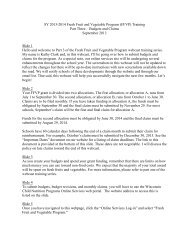Vendor Agreement to Provide Meals/Snacks - WI Child Nutrition ...
Vendor Agreement to Provide Meals/Snacks - WI Child Nutrition ...
Vendor Agreement to Provide Meals/Snacks - WI Child Nutrition ...
You also want an ePaper? Increase the reach of your titles
YUMPU automatically turns print PDFs into web optimized ePapers that Google loves.
CHILD AND ADULT CARE FOOD PROGRAM(<strong>Child</strong> Care Component)VENDOR AGREEMENT TO PROVIDE MEALS/SNACKSThis agreement is executed between _________________________________________________________ and(Name of <strong>Vendor</strong>)____________________________________________________________________________________________(<strong>Child</strong> Care Facility)Whereas the facilities of _________________________________________________________________________(Name of <strong>Vendor</strong>)agree <strong>to</strong> operate in accordance with the <strong>Child</strong> and Adult Care Food Program (CACFP) regulations 7 CFR 226. Thisincludes that the facility is adequate <strong>to</strong> prepare the required number of meals and snacks; has a current federal,state, or local health certification; and adheres <strong>to</strong> the health and sanitation requirements.___________________________________________________________________________________________(Name of <strong>Vendor</strong>)agrees <strong>to</strong> supply the following meals <strong>to</strong> _____________________________________________________________(<strong>Child</strong> Care Facility)located at:_________________________________________________________________________________(<strong>Child</strong> Care Facility Location)A. Check all that apply: Breakfast Snack Lunch SupperB. These meals/snacks will be delivered: Unitized (individual packaged meals) Non-unitizedC. The portion sizes and components for the meals and snacks will be provided in accordance with current meal andsnack pattern guidelines established by the United States Department of Agriculture and required under the <strong>Child</strong>and Adult Care Food Program. Documentation including delivery slips, production records, <strong>Child</strong> <strong>Nutrition</strong> (CN)labels, and other documentation that demonstrates meal pattern compliance will be provided <strong>to</strong> the center onrequest. Refer <strong>to</strong> Attachment A for the meal patterns.D. <strong>Meals</strong>/snacks shall be delivered/picked up by _____________________________________________________(Indicate “delivered” or “picked up”) (Specify <strong>Vendor</strong> or <strong>Child</strong> Care Facility)at __________________.(Specify Time)E. __________________________________________________________________ will provide proper containers(Specify <strong>Vendor</strong> or <strong>Child</strong> Care Facility)<strong>to</strong> maintain safe temperatures of food and milk while in transit.F. The number of meals <strong>to</strong> be supplied will be ___________. The number of meals may be increased or decreased_______________________________ by ________________________________________________________(How frequently)(Specify the time and date as well as method for adjusting orders)G. The price of meals shall be: Breakfast $_____________________________ eachSnack$_____________________________ eachLunch$_____________________________ eachSupper$_____________________________ each(OVER)Guidance Memorandum 13C, revision date 6/13See the DPI CACFP website at http://fns.dpi.wi.gov/fns_centermemos for the most current version.1
H. The_____________________________________________________________________________________(<strong>Child</strong> Care Facility)will not pay_______________________________________________________________________________(Name of vendor)for meals which are delivered outside of the agreed upon delivery time, are spoiled or unwholesome at the timeof delivery, or do not otherwise meet the meal requirements for the CACFP.IN FURTHER AGREEMENT ___________________________________________________________, pursuant <strong>to</strong>(Name of <strong>Vendor</strong>)the provisions of the <strong>Child</strong> and Adult Care Food Program Regulations, will assure that said meals and snacks meetthe minimum requirements for nutritive value and content, and will maintain full and accurate records that the <strong>Child</strong>Care Institution will need <strong>to</strong> meet its responsibility, including the following:1. Menu RecordsDaily menu records and daily production records listing the <strong>to</strong>tal amount of food prepared, and dailydelivery records listing amounts of food supplied.2. Meal BillingA bill including the <strong>to</strong>tal number of meals and snacks supplied by type and <strong>to</strong>tal charge must be reported<strong>to</strong> the <strong>Child</strong> Care Institution promptly at the end of each month.Retain the meal service records specified above for a period of three (3) years from the date of receipt of finalpayment under the contract, or in cases where an audit requested by the State agency or the Department remainsunresolved, until such time as the audit is resolved. Upon request, make all accounts and records pertaining <strong>to</strong> theprogram available <strong>to</strong> representatives of the State of Wisconsin Department of Public Instruction, United StatesDepartment of Agriculture, and the federal General Accounting Office for audit or administrative review at areasonable time and place.IN THE EVENT the vendor is receiving Federal assistance under the <strong>Child</strong> and Adult Care Food Program, NationalSchool Lunch Program, School Breakfast Program, Special Milk Program, or Summer Food Service Program, or isreceiving donated commodities, the following paragraph shall be considered a part of this <strong>Agreement</strong>.Payments made <strong>to</strong> the vendor under this <strong>Agreement</strong> shall be deposited in<strong>to</strong> its non-profit food service account and allexpenditures made by the vendor in connection with this <strong>Agreement</strong> shall be paid from such account.THIS AGREEMENT shall be effective as of _______________________ until ______________________________.It may be terminated by notice in writing given by either party <strong>to</strong> the other at least thirty (30) days prior <strong>to</strong> the date oftermination. The following parties have executed this <strong>Agreement</strong>, effective the month, day, and year specified above.___________________________________________ __________________________________________(<strong>Vendor</strong> Representative)(<strong>Child</strong> Care Facility's CACFP AuthorizedRepresentative)___________________________________________ __________________________________________(Title)(Title)___________________________________________ __________________________________________(Date)(Date)Guidance Memorandum 13C, revision date 6/13See the DPI CACFP website at http://fns.dpi.wi.gov/fns_centermemos for the most current version.2
ATTACHMENT ACACFP Meal Pattern Requirements—<strong>Child</strong>ren (Age 1 through 12) iThe meal must contain, at a minimum, each of the components listed in at least the amounts indicated for the specific age groupin order <strong>to</strong> qualify for reimbursement.Age 1 & 2 Age 3, 4, & 5 Age 6 through l2 iBREAKFAST1. Milk, fluid J 1/2 cup 3/4 cup 1 cup2. Juice, a fruit or vegetable or 1/4 cup 1/2 cup 1/2 cupFruit(s) or vegetable(s) 1/4 cup 1/2 cup 1/2 cup3. Grains/Breads: bBread 1/2 slice 1/2 slice 1 sliceCornbread, biscuits, rolls, muffins, etc b 1/2 serving 1/2 serving 1 servingCereal:Cold dry 1/4 cup or 1/3 oz c 1/3 cup or 1/2 oz c 3/4 cup or 1 oz cHot cooked 1/4 cup <strong>to</strong>tal 1/4 cup 1/2 cupCooked pasta or noodle products 1/4 cup 1/4 cup 1/2 cupLUNCH OR SUPPER1. Milk, fluid J 1/2 cup 3/4 cup 1 cup2. Meat or meat alternate:Meat, poultry, fish, cheese 1 oz 1+1/2 oz 2 ozAlternate protein products g 1 oz 1+1/2 oz 2 ozYogurt, plain or flavored, unsweetened or sweetened 4 oz or 1/2 cup 6 oz or 3/4 cup 8 oz or 1 cupEgg 1/2 egg 3/4 egg 1 eggCooked dry beans or peas 1/4 Cup 3/8 cup 1/2 cupPeanut butter or other nut or seed butter 2 Tbsp. 3 Tbsp. 4 Tbsp.Peanuts or soynuts or tree nuts or seeds 1/2 oz = 50% d 3/4 oz = 50% d 1 oz = 50% d3. Vegetable and/or fruit e (at least two) 1/4 cup <strong>to</strong>tal 1/2 cup <strong>to</strong>tal 3/4 cup <strong>to</strong>tal4. Grains/Breads: bBread 1/2 slice 1/2 slice 1 sliceCornbread, biscuits, rolls, muffins, etc b 1/2 serving 1/2 serving 1 servingCereal, hot cooked 1/4 cup <strong>to</strong>tal 1/4 cup 1/2 cupCereal, cold, dry 1/4 cup or 1/3 oz c 1/3 cup or 1/2 oz c 3/4 cup or 1 oz cCooked pasta or noodle products 1/4 cup 1/4 cup 1/2 cupSNACKSelect two of the following four components:1. Milk, fluid J 1/2 cup 1/2 cup 1 cup2. Juice, a,f fruit or vegetable or 1/2 cup 1/2 cup 3/4 cupFruit(s) or vegetable(s) 1/2 cup 1/2 cup 3/4 cup3. Grains/Breads: bBread 1/2 slice 1/2 slice 1 sliceCornbread, biscuits, rolls, muffins, etc b 1/2 serving 1/2 serving 1 servingCereal:Cold dry 1/4 Cup or 1/3 oz c 1/3 cup or 1/2 oz c 3/4 cup or 1 oz cHot cooked l/4 cup 1/4 cup 1/2 cup4. Meat or meat alternateMeat, poultry, fish, cheese 1/2 oz 1/2 oz 1 ozAlternate protein products g 1/2 oz 1/2 oz 1 ozEgg, Large h 1/2 egg 1/2 egg 1/2 eggCooked dry beans or peas 1/8 Cup 1/8 cup 1/4 cupPeanut butter or other nut or seed butter 1 Tbsp. 1 Tbsp. 2 Tbsp.Peanuts or soynuts or tree nuts or seeds 1/2 oz 1/2 oz 1 ozYogurt, plain or flavored, unsweetened or sweetened 2 oz or 1/4 cup 2 oz or 1/4 cup 4 oz or 1/2 cupa Must be full strength fruit or vegetable juice.b Bread, pasta or noodle products, and cereal grains shall be whole grain or enriched, cornbread, biscuits, rolls, muffins, etc., shall be made with wholegrain or enriched meal or flour.c Either volume (cup) or weight (oz), whichever is less.d No more than 50% of the requirement shall be met with tree nuts or seeds. Tree nuts and seeds shall be combined with another meat/meat alternate <strong>to</strong>fulfill the requirement. For purpose of determining combinations, 1 oz. Of nuts or seeds is equal <strong>to</strong> 1 oz. of cooked lean meat, poultry or fish.e Serve 2 or more kinds of vegetable(s) and/or fruit(s). Full strength vegetable or fruit juice may be counted <strong>to</strong> meet not more than one-half of thisrequirement.f Juice may not be served when milk is the only other component.g Alternate protein products may be used as acceptable meat alternates if they meet the requirements on the following page.h One-half egg meets the required minimum amount (one-ounce or less) of meat alternate.i Youth ages 13 through 18 must be served minimum or larger portion sizes than those specified for ages 6 through 12.j. Fluid milk must be fat-free (skim) or low-fat milk.Guidance Memorandum 13C, revision date 6/133See the DPI CACFP website at http://fns.dpi.wi.gov/fns_centermemos for the most current version.
ATTACHMENT AAlternate Protein ProductsA. What are the criteria for alternate protein products used in the <strong>Child</strong> and Adult Care Food Program?1. An alternate protein product used in meals planned under the provisions in Sec. 226.20 must meet all of thecriteria in this section.2. An alternate protein product whether used alone or in combination with meat or meat alternate must meet thefollowing criteria:a. The alternate protein product must be processed so that some portion of the non-protein constituents ofthe food is removed. These alternate protein products must be safe and suitable edible productsproduced from plant or animal sources.b. The biological quality of the protein in the alternate protein product must be at least 80 percent that ofcasein, determined by performing a Protein Digestibility Corrected Amino Acid Score (PDCAAS).c. The alternate protein product must contain at least 18 percent protein by weight when fully hydrated orformulated. (``When hydrated or formulated'' refers <strong>to</strong> a dry alternate protein product and the amount ofwater, fat, oil, colors, flavors or any other substances which have been added).d. Manufacturers supplying an alternate protein product <strong>to</strong> participating schools or institutions must providedocumentation that the product meets the criteria in paragraphs A.2. a through c of this appendix.e. Manufacturers should provide information on the percent protein contained in the dry alternate proteinproduct and on an as prepared basis.f. For an alternate protein product mix, manufacturers should provide information on:(1) The amount by weight of dry alternate protein product in the package;(2) Hydration instructions; and(3) Instructions on how <strong>to</strong> combine the mix with meat or other meat alternates.B. How are alternate protein products used in the <strong>Child</strong> and Adult Care Food Program?1. Schools, institutions, and service institutions may use alternate protein products <strong>to</strong> fulfill all or part of themeat/meat alternate component discussed in Sec. 226.20.2. The following terms and conditions apply:a. The alternate protein product may be used alone or in combination with other food ingredients.Examples of combination items are beef patties, beef crumbles, pizza <strong>to</strong>pping, meat loaf, meat sauce,taco filling, burri<strong>to</strong>s, and tuna salad.b. Alternate protein products may be used in the dry form (nonhydrated), partially hydrated or fullyhydrated form. The moisture content of the fully hydrated alternate protein product (if prepared from adry concentrated form) must be such that the mixture will have a minimum of 18 percent protein byweight or equivalent amount for the dry or partially hydrated form (based on the level that would beprovided if the product were fully hydrated).C. How are commercially prepared products used in the <strong>Child</strong> and Adult Care Food Program?Schools, institutions, and service institutions may use a commercially prepared meat or meat alternate productcombined with alternate protein products or use a commercially prepared product that contains only alternateprotein products.Guidance Memorandum 13C, revision date 6/13See the DPI CACFP website at http://fns.dpi.wi.gov/fns_centermemos for the most current version.4
ATTACHMENT ACACFP Infant Meal PatternBirth through 11 MonthsTo comply with the <strong>Child</strong> and Adult Care Food Program regulations, it is the responsibility of child care centers caringfor infants <strong>to</strong> purchase all required meal components on the Infant Meal Pattern according <strong>to</strong> the different age groupsin care. The Infant Meal Pattern lists the minimum amount of food <strong>to</strong> be offered <strong>to</strong> infants from birth through 11months. The infant meal must contain each of the following components in at least the amounts indicated for theappropriate age group in order <strong>to</strong> qualify for reimbursement. Food within the meal pattern should be the texture andconsistency appropriate for the development of the infant and may be served during a span of time consistent withthe infant's eating habits; for example, the food items for lunch might be served at two feedings between 12 noon and2 p.m. Solid food should be introduced gradually <strong>to</strong> infants when developmentally ready and instructed by the parent.Items on the following meal chart with a “” indicate the items are required and must be provided <strong>to</strong> theinfant in order <strong>to</strong> claim reimbursement for that meal. Items listed under “When developmentally ready” arerequired only when the infant is developmentally ready <strong>to</strong> accept them.Birth through 3 months 4 through 7 months 8 through 11 monthsBreakfast 4–6 fl oz formula 1 or 4–8 fl oz formula 1 orbreast milk 2, 3 breast milk 2, 3 6–8 fl oz formula 1 orbreast milk 2, 3 andWhen developmentally ready 2–4 T infant cereal 11–4 T fruit or vegetable or bothandLunch/Supper4–6 fl oz formula 1 or 4–8 fl oz formula 1 orbreast milk 2, 3 breast milk 2, 3When developmentally ready0–3 T infant cereal 1and0–3 T fruit or vegetable or bothSnack 6–8 fl oz formula 1 orbreast milk 2, 3 and 1–4 T fruit or vegetable or bothand 2–4 T infant cereal 1or in place of infant cereal youmay serve a meat/meat alternateo 1–4 T meat, fish, poultry, eggyolk, cooked dry beans orpeas; or ½–2 oz cheese; or 1–4 oz (volume) cottage cheese;or 1–4 oz (weight) cheesefood, cheese spreador you may also serveo both the infant cereal andmeat/meat alternate4–6 fl oz formula 1 or 4–6 fl oz formula 1 or 2–4 fl oz formula 1 orbreast milk 2, 3 breast milk 2, 3 breast milk, 2, 3 orfruit juice 4When developmentally ready0–½ slice bread 5or0–2 crackers 51 Infant formula and dry infant cereal must be iron-fortified.2 Breast milk or formula, or portions of both, may be served; however, it is recommended breast milk be served inplace of formula from birth through 11 months.3 For some breastfed infants who regularly consume less than the minimum amount of breast milk per feeding, aserving of less than the minimum amount of breast milk may be offered with additional breast milk offered if theinfant is still hungry.4 Fruit juice must be full-strength.5 A serving of this component must be made from whole-grain or enriched meal or flour.Guidance Memorandum 13C, revision date 6/13See the DPI CACFP website at http://fns.dpi.wi.gov/fns_centermemos for the most current version.5


